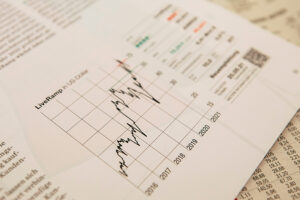This time it is different - Saxo Bank's forecasts for QXNUMX
“Throughout history, rich and poor countries have dealt with an extraordinary series of financial crises by granting loans, borrowing them, bankruptcy - and then economic recovery. Each time, national experts maintained that 'this time is different', that the current valuation rules no longer apply, and the new situation does not resemble previous catastrophes ”- Carmen Reinhart & Kenneth Rogoff, This Time is Different.
The book by Reinhart and Rogoff, This Time is Different, published in 2011, is a bold attempt to define what preconditions, in particular in terms of the levels of cumulative domestic and foreign debt in relation to CBAcause that a given country begins to move towards an inevitable crisis. The exhaustive research presented in the book was based on data from 66 countries and five continents. They showed that in 2011, the largest developed markets had been moving towards another crisis for some time, as the political response to the global financial crisis had resulted in a significant accumulation of additional and "unsustainable" debt. Since this publication, numerous rounds of quantitative easing have significantly delayed this crisis, and perhaps even refuted the book's keynote.
Pandemic and debt levels
However, the size and nature of the political response to the pandemic shows that this time around, the effects of inflation will actually be very different from anything we've seen in the last few decades, even if in the end Reinhart and Rogoff's general thesis that debt accumulation always leads to serious problems is confirmed. This is due to the fact that with such high debt levels, monetary policy is no longer effective when effective interest rates are zero. To prevent an immediate crisis, the measures taken in response to the pandemic included military mobilization-scale fiscal stimulus, basic income support and Modern Monetary Theory (MMT) style direct transfers to almost every sector of the economy.
It was a huge boost to demand at a time when the economy was closing the supply side to fight the virus. And even now, as we open up after the pandemic, the new fiscal dominance will not disappear because we are dealing with three generational challenges simultaneously: inequality, infrastructure and climate policy, i.e. green transformation.
The economic effects of this new approach include even greater governance, more invasive regulations, disruptions to supply chains, inflation, lack of price discovery, an overall strong left turn in the West, and increased "diverting of capital" to small niches of resources and assets to invest in . It may mean a return to the situation from the 70s, but this time the key is the political imperative concerning decarbonization of the economyregardless of the impact of this process on real growth.
Green transformation
A retreat from coal is of course absolutely necessary, but currently available technologies are not suitable for this purpose because solar or wind energy is not scalable due to production interruptions. Even worse is the over-advocated switch to lithium-ion battery-powered electric vehicles. European wind turbines have to be stopped in high winds because the grid is not designed to accommodate peaks. And even if some form of energy storage were available, the amount of industrial metals needed to do so might not be enough.
Summarizing, our main problem is that the physical world is too small to fulfill the aspirations and visions of our politicians and environmental movements. The more we move away from coal under the current model, the more our economy will be metal dependent. Assuming that 2030% of the car fleet will be powered by electricity in 30, marginal metal demand will be ten or twenty times higher than current levels. At the same time, supply chains are inflexible due to a lack of support for licensing, board approval, and no capital flows to the dirty side of production due to ESG priorities.
ESG and green agenda
The latest investment trend is ESG, in particular "E" (environment), which is everything related to green transformation. The inflow of funds to priority ESG areas continues, and companies are outdoing each other in adapting to this trend, which is a key factor in economic activity and access to capital. This is excellent news, as long as we ignore the fact that the ESG environment is not precisely defined at best, is not based on any rules and is often discretionary. However, this does not in any way affect my key message to clients and politicians, which is:
ESG is the largest political project in history
The emphasis on ESG and the associated green transition is based on so much political capital that failure is simply not an option. I consider the euro as the best analogy. I was a student of Professor Niels Thygesen at the time he compiled the Delors Commission report from 1988 to 1989, preceding the introduction of the euro and paving the way to Economic and Monetary Union. We were all aware that the concept of the EMU / Euro lacked the appropriate foundations (in the form of a fiscal union), that no monetary union has stood the test of time, and that stronger states will "water down" weaker countries. Even so, we have all underestimated the political capital invested. As with the Green Agenda and ESG, this endeavor was doomed to success.
All doubts were dispelled on July 26, 2012 during the President's speech EBC Mario Draghi at the Global Investment Conference in London, during one of the worst phases of the EU sovereign debt crisis, when Draghi stated: “As part of our mandate, the ECB stands ready to take all possible measures to save the euro. And believe me - that's enough ".
About the Author
Steen Jakobsen, Chief Economist and CIO Saxo Bank. Djoined Saxo in 2000. As a CIO, he focuses on developing asset allocation strategies and analyzing the overall macroeconomic and political situation. As head of the SaxoStrats team, Saxo Bank's internal team of experts, he is responsible for all research, including quarterly forecasts, and was the founder of Saxo Bank's outrageous forecasts. Before joining Saxo Bank he cooperated with Swiss Bank Corp, Citibank, Chase Manhattan, UBS and was the global head of trade, currency and options in Christiania (currently Nordea). Jakobsen's approach to trading and investing is thought-provoking and is not afraid to oppose consensus. This often causes debate among the global market community. Every day, Jakobsen and his team conduct research in various asset classes, covering major macroeconomic changes, market movements, political events and central bank policies. With over 30 years of experience, Jakobsen regularly appears as a guest at CNBC and Bloomberg News.
I would liken the current program / factor to the same political ideology. The ESG and the green agenda will win, if only because of the unprecedented political will and capital on which they are based. Bloomberg Intelligence estimates that by 2025 the value of ESG assets will amount to $ 50 trillion (for comparison, US GDP is $ 23 trillion annually).
So we are dealing with the largest scale of "all possible measures" in history and they are global - China joined the program with a plan to decarbonise by 2050.
ESG and the green transition are simply the greatest political stakes ever undertaken, with inflation and even lower real rates being the main consequences. In this case, inflation will be a function of the inability of the physical world to supply a corresponding quantity of money and demand, while negative real interest rates this is a signal that real economic growth is facing low due to a modest increase in productivity.
New sources of energy
We investors need to acknowledge it, understand it and act accordingly. There are two main classes of assets that will do well under such a regime: government sanctioned assets and price discovery assets. This means that in the long run, green assets and, ironically, raw materials will provide the best chance of additional return.
This does not mean that such a projection will only predict a series of successes. On the contrary: the current model of negative real rates as a source of financing for unproductive social change will lead to some kind of collapse. However, this will only result in an even greater influx of funds and subsidies for the same flawed process. It is hoped that eventually new energy sources (fusion energy?) Will come to the rescue with much better efficiency per unit of energy invested and per dollar invested. For now, however, the main argument is money.
In summary, negative real interest rates are a function of the future non-productivity of our economic model. The more we pursue a suboptimal delivery model - an otherwise noble goal of a cleaner, better and fairer future - the lower the real rates will be and the greater social inequality will be, blocking the way to a realistic vision of the future.
Such a vision should be based on productive communities receiving better education, devoting the bulk of fiscal spending to basic research, and the rules-based international collaboration that gave us the vaccine against Covid, genome mapping, the Internet and much more. The sad thing is that we have never been so distant from this "turn in the right direction".
This time is different
So let's repeat: this time is different, because we are facing a new inflationary era that no one under 60 remembers. The aspect that does not change, however, is that we are dealing with the final phase of a process initiated under Greenspan in 1998, where politicians intervene even more in the economy. Originally this concerned central banks saving the system, today they are governments seeking to enforce certain outcomes regardless of their productivity. This is what has led to zero interest rates and now strongly negative real rates. We need to realize that negative real interest rates are a doom loop and we will not be able to move for good towards the bright future we want to create until real rates go up and turn positive.
All Saxo Bank's forecasts are available at: https://www.home.saxo/insights/news-and-research/thought-leadership/quarterly-outlook






















![Forex Club – Tax 9 – Settle tax on a foreign broker [Download the Application] Forex Club - Tax 9](https://forexclub.pl/wp-content/uploads/2024/02/Forex-Club-Podatek-9-184x120.jpg?v=1709046278)
![Trading View platform – solutions tailored to the needs of traders [Review] trading view review](https://forexclub.pl/wp-content/uploads/2024/03/trading-view-recenzja-184x120.jpg?v=1709558918)
![How to connect your FP Markets account to the Trading View platform [Guide] fp markets trading view](https://forexclub.pl/wp-content/uploads/2024/02/fp-markets-trading-view-184x120.jpg?v=1708677291)
![How to invest in ChatGPT and AI? Stocks and ETFs [Guide] how to invest in chatgpt and artificial intelligence](https://forexclub.pl/wp-content/uploads/2023/02/jak-inwestowac-w-chatgpt-i-sztuczna-inteligencje-184x120.jpg?v=1676364263)


![WeWork – the anatomy of the collapse of a company valued at $47 billion [WeWork, part II] wework bankruptcy story](https://forexclub.pl/wp-content/uploads/2024/04/wework-bankructwo-historia-184x120.jpg?v=1711729561)
![Adam Neumann – the man who screwed up Softbank [WeWork, part AND] adam neumann wework](https://forexclub.pl/wp-content/uploads/2024/04/adam-neumann-wework-184x120.jpg?v=1711728724)





![How to transfer shares to another brokerage office [Procedure description] how to transfer shares to another brokerage house](https://forexclub.pl/wp-content/uploads/2024/03/jak-przeniesc-akcje-do-innego-biura-maklerskiego-184x120.jpg?v=1709556924)

![The most common mistakes of a beginner trader - Mr Yogi [VIDEO] Scalping - The most common mistakes of a beginner trader - VIDEO](https://forexclub.pl/wp-content/uploads/2024/03/Scalping-Najczestsze-bledy-poczatkujacego-tradera-VIDEO-184x120.jpg?v=1711601376)
![Learning patience: No position is also a position - Mr Yogi [VIDEO] Scalping - Learning patience - No position is also a position - VIDEO](https://forexclub.pl/wp-content/uploads/2024/03/Scalping-Nauka-cierpliwosci-Brak-pozycji-to-tez-pozycja-VIDEO-184x120.jpg?v=1710999249)
![When to exit a position and how to minimize losses - Mr Yogi [VIDEO] Scalping - When to exit a position and how to minimize losses - VIDEO](https://forexclub.pl/wp-content/uploads/2024/03/Scalping-Kiedy-wyjsc-z-pozycji-i-jak-minimalizowac-straty-VIDEO-184x120.jpg?v=1710336731)






![Will global warming help wheat? [Webinar] wheat raw materials webinar](https://forexclub.pl/wp-content/uploads/2024/03/pszenica-surowce-webinar-300x200.jpg?v=1711099347)











